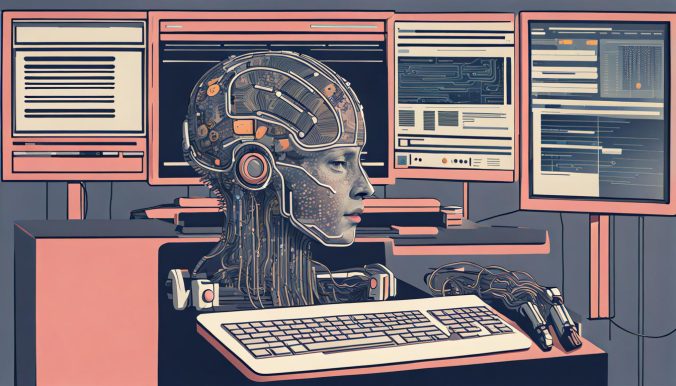Note: This is a long article, written from a very personal take on Artificial Intelligence.
The current hype word seems to be “Artificial Intelligence” or in its short form “AI. If one is to believe what people say, AI is now everywhere, threatening everything from artists to industrial workers. There is even the (in)famous letter, written by some “experts” in the field, calling for an immediate halt to the development of new and better AI systems. But nothing really happened after that, and now the DANGER is apparently hovering over us all. Or is it?
Hint: Yes, it is, but also not in the way we might think!
The term “Artificial Intelligence” has recently been watered out in media and advertisements, so that the words almost don’t mean anything anymore. Despite this, the common ideas seem to be that we should 1) either be very, very afraid, or 2) hurriedly adapt to the new technology (AI) as fast as possible. But why should we be afraid at all, and for what? When asked, people often reply that AI will replace everybody at work, or that evil AI will take over anything from governments to the world as a whole. This latter is of course also a common theme for science fiction books and movies. Still, neither of these are really good reasons to fear the current development. But in order to understand why this is so, we need to go back to the historical roots of Artificial Intelligence.
What do we Mean by AI, then?
Artificial Intelligence started as a discipline in 1956 during a workshop at Dartmouth College, USA. During the discipline development, a distinction between two directions formed, that between strong and weak AI. Strong AI aims at replicating a human type of intelligence, whereas weak AI aimed at develop computations methods or algorithms that made use of ideas gained from Human Intelligence (often for specific areas of computation). Neural networks are, for example, representative of the weak AI directions. Today, strong AI is also referred to as AGI (Artificial General Intelligence), meaning a non-specialized artificial agent.
But in the 1950:s and 1960:s computers were neither as fast, nor as large as the current computers, which at that time imposed severe limitations on what you were able to do within the field. A large amount of work was theoretical, but there were some interesting implementations, such as Eliza, SHRDLU and not least Conceptual Dependencies (I have chosen these three examples carefully, since each of these poses some interesting properties with respect to AI, and I will explain this in the following and then follow up on the introduction):
Conceptual Dependencies : Conceptual Dependencies is an example of a very successful implementation of an artificial system with a very interesting take on knowledge representation. The system was written in the programming language LISP, and attempted to extract the essential knowledge that hid in the texts. The result was a conceptual dependency network, that could then be used successfully to summarize news articles on certain topics (the examples were taken from natural disasters and airplane hijacking). There were also attempts to make the system produce small (children’s) stories. All in all, the problem was that the computers were too small to be practically useful.
SHRDLU : SHRDLU was a virtual system that worked by having a small robot manipulating geometric shapes in a 3D modelling world. It was able to reason about the different possible or impossible moves, for example, that it is not possible to put a cube on top of a pyramid, but it is OK to do the reverse. The problem with SHRDLU was that there were some bugs in the representation and the reasoning, which ended in that it was pointed out that the examples shown were most likely preselected and did not display any general reasoning capabilities.
Eliza : The early chatbot Eliza is probably most known as the “Computer Psychologist”. It was able to keep up a conversation with a human for some time, pretending to be a Psychologist and it did so well that it was enough to actually convince some people that it was a real Psychologist behind the screen. “But, hold it!” someone may say here, “Eliza was not a real artificial intelligence! It was a complete fake!”. And yes, you would be perfectly right here. Eliza was a fraud, not so that it wasn’t a computer program, but in that it was faking the “understanding” of what the user wrote. But this is exactly the point with mentioning Eliza here. A intelligence-like behaviour may fool many, even though it does not have any “intelligent system” under the hood.
What can we Learn from AI History?
The properties of these three historical systems that I would like to point to in more detail are as follows:
- Conceptual dependencies: AI needs some kind of knowledge representation. At least some basic knowledge must be stored in some way as a basis for the interpretation of the prompts.
- SHRDLU : An artificial agent needs to be able to do some reasoning about this knowledge. Knowledge representation is only useful if it possible to use it for reasoning and possible generation of new data.
- Eliza : Not all AI-like systems are to be considered to be real Artificial Intelligence. In fact Joseph Weizenbaum created Eliza in order to prove exactly how easy it was to emulate some “intelligent behaviour”.
To start with these three examples also have one interesting common property, namely that they are transparent since the theory and implementations have been made public. This is actually a major problem with many of the current generative AI agents, since they are based on large amounts of data, the source listings of which are not publicly available.
The three examples above also point to additional problems with the generative modelling approaches to AI (those that are currently considered so dangerous). In order to become an AGI (artificial general intelligence) it is most likely that there needs to be some kind of knowledge base, and an ability to reason about this knowledge. We could in fact regard the large generative AI agents as very advanced versions of Eliza, in some cases also enhanced with search abilities in order to give better answers, but as a matter of fact they don’t really produce “new” knowledge, just phrases that are the most probable continuations of the texts in the prompts. Considering the complexity of languages this is in itself no small feat, but it is definitely not a form of intelligent reasoning.
The similarity to Eliza is increased by the way the answers are given to a person, in that they are given in a very friendly form, even having the system apologize when it is pointed out that the answer it has given is not correct. This conversational style of interaction can easily fool users who are less knowledgeable about computers that there is a genie in the system, which is very intelligent and (very close to) a know-it-all. More about this problem later in this post.
Capabilities of and Risks with Generative AI?
The main problem that has arisen is that the generative AI systems cannot produce any real novelties, since the answers are based on (in the best case, extrapolation of) existing texts (or pictures). Should they by any chance produce new knowledge, there is no way to know whether this “new knowledge” is correct or not! And here is where, in my opinion, the real danger with generative AI lies. If we ask for information we either get correct “old” information, or new information which we cannot know whether it is correct or not. And we are only given one single answer per question. In this sense the chatbots could be compared to the first version of Google search, which contained a button marked “I’m feeling lucky!”, an option which just gave you one single answer, and not as now hundreds of pages to look through.

The chatbots also provide single answers (longer of course), but in Eliza manner wrapped in a conversational style that is supposed to convince the user that the answer is correct. Fortunately (or not?), the answers are often quite correct, so they will in most cases provide both good and useful information. However, all results still need to be “proof-read” in order to guarantee the validity of the contents. Thus, the users will have to apply critical thinking and reasoning to a high extent when using the results. Paradoxically, the better the systems become, i.e., the more of the results that are correct, the more we need to check the results in detail, especially when critical documents are to be produced where an error may have large consequences.
Impressive systems for sure!
Need we be worried about the AI development, then? No, today there is no real reason to worry about the development as such, but we need to be more concerned about the common usage of the results from AI systems. It is necessary to make sure that the users do understand that chatbots are not intelligent in the sense we normally think. They are good at (re-)producing text (and images), which most of the time make them very useful supportive tools for writers and programmers, for example. Using the bots to create text that can be used as a base for writing a document or an article is one interesting example of where this kind of systems will prove to be very important in the future. It will still be quite some time before they will be able to write an exiting and interesting novel, without the input and revision of a human author. Likewise, I would be very hesitant about using a chatbot to write a research article, or even worse, a text book in any topic. These latter usages will definitely require a significant amount or proof-reading, fact-checking and not least rewriting, before being released.
The AI systems that are under debate now are still very impressive creations, of course, and they manifest a significant progress in the engineering of software. The development of these systems is remarkable, and they have a potential to become very important in society, but they do not really produce really intelligent behaviour. The systems are very good statistical language generators, but with a very, very advanced form of Eliza at the controls
The future?
Will there be AGI, or strong AI beings in the future? Yes, undoubtedly, but this will take a long time still (I am prepared to be the laughing stock in five years, if they arrive. And these systems will most likely be integrated with the generative AI we have to day for the language management. Still, we will most likely not be able to get there, as long as we forget about the use of some kind of knowledge network underneath. It might not be in the classic form as mentioned above, but it seems that knowledge and reasoning strategies, rather than statistical models has to form some kind of underlying technology.
How probable is this different development path leading to strong AI, or AGI systems? Personally, I think it is quite probable and it seems to be doable, but I am also very curious about how the development will proceed over time. I would be extremely happy if an AGI could be born in my life time (being 61 at the time of writing).
And hopefully these new beings will be in the shape of benevolent, very intelligent agents, that can cooperate with humans in a constructive way. I still have the hope. Please feel free to add your thought in the comments below.



